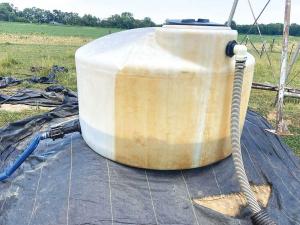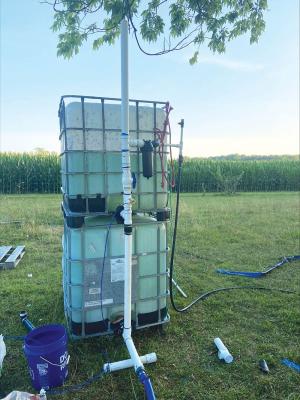2023 - Volume #47, Issue #5, Page #24
[ Sample Stories From This Issue | List of All Stories In This Issue | Print this story
| Read this issue]
Pasture Water System Fills Itself
 |
 |
Water flows out of a spring-fed upper pond through a 10-in. pipe, releasing water to a lower pond. Wood uses the elevation difference between the two ponds to move water as needed. As water leaves the pipe, it runs across a 2 by 6-ft. pallet covered in poly roofing and into a split 55-gal. barrel. From there, it loses about 3 ft. of elevation, running downhill through pvc pipes to a set of ram pumps.
“I have a 1 1/4-in. ram pump that I use most of the time, but if the water flow drops, I can switch to the smaller pump,” says Wood. “The bigger ram pump lifts the water 10 to 12 ft. to my water tower.”
Wood placed two 270-gal. IBC totes, one on top of the other, on the highest point of his farm for a water tower. Three-quarter-inch poly pipe carries the water to a standpipe connected to the stacked totes. Air lock is prevented in the lower tank by an airline in the tank cap that extends above the upper tank. Before reaching the standpipe, the water passes through an Arkal disc filter.
“The filter knocks algae, sediment, and sand particles out of the water,” says Wood. “I also have a valve in the pipe ahead of the filter to bleed air out of the system. Trapped air is not your friend.”
The standpipe has an exit valve at its bottom, leading to a 700-ft., 3/4-in. poly pipe that runs to a 550-gal. tank near Wood’s high tunnel. The tank is on the same level as the totes. As they fill, so does the tank.
“The 550-gal. tank gives me 3 to 4 ft. of head pressure, sufficient for drip irrigation,” says Wood. “Pressure also is increased as I reduce the water lines from 3/4-in. to 1/2-in. drip lines.”
A tap on the poly pipe ahead of the tank lets Wood run water lines to chicken tractors in the nearby field.
Overflow on the tank from the constantly running ram pump drains downhill to the upper pond.
“I’ve run drip irrigation for half an hour, and the tank is still overflowing,” says Wood.
Wood designed the system with bypass valves on the totes and the tank. If he needs to work on any one of the three, he can do so without shutting down the ram pump.
“I’ve been using the system for going on 5 years,” says Wood. “Most of it was salvage or picked up at auction. I got the 700 ft. of poly pipe for only $60 at a nearby Amish auction. I couldn’t have afforded it new.”
He did buy the ram pumps new, ordering them from an online supply company. Land To House (www.landtohouse.com) specializes in ram pump kits and components. The 1 1/4-in. ram pump kit is priced at $180. The smallest of four models is a 1/2-in. ram pump kit for $80.
“Land to House provides all the pipe ratios and head pressure information needed,” says Wood. “I simply followed their recommendations.”
Wood has videos posted to his YouTube channel detailing how the system works and the changes he’s made.
Contact: FARM SHOW Followup, Brad Wood, P.O. Box 54, Centerville, Ind. 47330 (ph 765-595-0408; brad@farmerbrad.com; www.farmerbrad.com).

Click here to download page story appeared in.

Click here to read entire issue
To read the rest of this story, download this issue below or click here to register with your account number.




